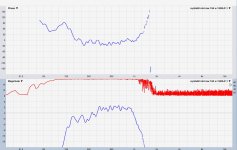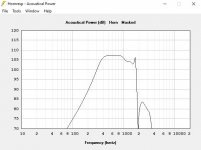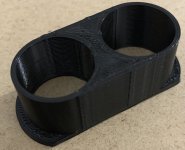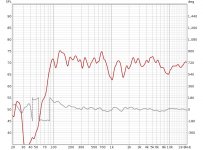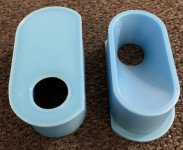It is exactly 4" from the center of the hole to the CD exit. Basically, they are as close as physically possible to the throat. It could be maybe squeezed closer a bit more. Version 2 will follow when version 1 is as good as possible.
That all ties together, makes sense.
What kind of processing do you have available?
I bet if you can get 300-800Hz smoothed out for the 8"s, and 800Hz up for the CD, that it will sound quite a bit better than expected, from just looking at the raw.
What kind of processing do you have available?
I bet if you can get 300-800Hz smoothed out for the 8"s, and 800Hz up for the CD, that it will sound quite a bit better than expected, from just looking at the raw.
I did some quick crossover, time alignment and a little EQ yesterday for some short listening in mono. There is definitely the point source effect, the apparent source of sound is somewhere in the middle of the horn, but not at the throat I would say. I also get a feeling of the "disappearing" effect, but that would show more in stereo.
There are still dips and peaks in the (in room measured) response, but it seems that this size and shape would work for me. I definitely need to get some different compression drivers, since the DE500 drops of at the high end pretty fast - I bought them second hand and it really seems that they measure differently from factory specs on any horn I use 🙁
Like here: https://www.diyaudio.com/forums/att...ial-es-800-horn-joseph-crowe-es-800wde500-jpg
Or here: https://www.diyaudio.com/forums/att...rameters-please-advise-de500babymulticell-jpg
There are still dips and peaks in the (in room measured) response, but it seems that this size and shape would work for me. I definitely need to get some different compression drivers, since the DE500 drops of at the high end pretty fast - I bought them second hand and it really seems that they measure differently from factory specs on any horn I use 🙁
Like here: https://www.diyaudio.com/forums/att...ial-es-800-horn-joseph-crowe-es-800wde500-jpg
Or here: https://www.diyaudio.com/forums/att...rameters-please-advise-de500babymulticell-jpg
Before I measured the 4" length along the wall - it is actually slightly less than 3 inches when measured in the horn axis. So the notch is lower than it should be. Also, there seems to be some extra bandpass rolloff that should not be there theoretically. I need to measure with the compression driver shorted as I saw somewhere if it makes a difference.
The 4NDF34 does not show the notch higher in the simulation (than the 8PE21s, however the ports can be closer to the throat and smaller). I think I will try to block some area of the port if I can measure any difference. And maybe, my favourite 3FE22s will go into temporary service on the smaller ports as well🙂
The 4NDF34 does not show the notch higher in the simulation (than the 8PE21s, however the ports can be closer to the throat and smaller). I think I will try to block some area of the port if I can measure any difference. And maybe, my favourite 3FE22s will go into temporary service on the smaller ports as well🙂
Last edited:
.Before I measured the 4" length along the wall - it is actually slightly less than 3 inches when measured in the horn axis. So the notch is lower than it should be. Also, there seems to be some extra bandpass rolloff that should not be there theoretically. I need to measure with the compression driver shorted as I saw somewhere if it makes a difference
I dunno pelanj, I've come to the conclusion that it's length along the wall that determines the notch frequency.
Because it seems the notch is formed by sound from the cone going back into the throat to sum destructively with the CD. Seems like that path has to be along the horn walls....i mean, path can't get any shorter than that can it?
Yeah, i've made a point to mention shorting the CD when measuring mids ...it can really change things. I think most folks know to short the mids when measuring the CD, but the fact a CD is a passive radiator also came as a measurement surprise to me.
The 4NDF34 does not show the notch higher in the simulation (than the 8PE21s, however the ports can be closer to the throat and smaller). I think I will try to block some area of the port if I can measure any difference. And maybe, my favourite 3FE22s will go into temporary service on the smaller ports as well🙂
Here's the 4NDF34 with port centers at 3.5" inches from throat along the wall. Hope it helps, oh 75x60 horn if it matters
(There's a 1500Hz lpf in place 96dB/oct.. with no effect on upper end rolloff.)
In the last few days I read a lot. It would make sense to me to measure along the horn. Thanks for the measurement. It looks like I need to get some new speakers later anyway.
To my knowledge (which might be wrong), Hornresp measures the port distance along the axis of the horn.
I see, so you're saying that when the axial length is listed as 10cm, the port may be at a distance of 14cm as measured along the wall. However when the edge of a spherical wavefront reaches the port at 14cm, the wavefront is also at 14cm along the central axis.
Perhaps David McBean would prefer to clarify this, however.
Perhaps David McBean would prefer to clarify this, however.
Hornresp measures the port distance along the axis of the horn.
Correct. All offsets in Hornresp are specified that way.
So here are my Hornresp records which should match the horn built (in theory). I would really appreciate if anyone could try to explain the difference (first measurement here https://www.diyaudio.com/forums/att...294-2-synergy-inspired-spl-runt-8pe21runt-jpg , will do more soon). I am pretty sure I am doing some beginner mistakes in my assumptions.
Attachments
hmm its almost like there is additional distance from the throat in real life compared to your simulation. The DE500 is a short driver so I don't think this is the cause.
Hi pelanj, sorry i can't help with tying HR to your build.
I kinda took off on my own way of fabricating different test horns, port locations, etc ...and have spent alot of time exploring those with measurements to try to learn boundaries and significance within the boundaries.
Just my way, cause i like to be able to mentally picture how things work down to the root; and building the test boxes / builds is pretty easy for me. (well, easier for me than sims haha)
Anyway, i don't know HR well enough to offer help.
I kinda took off on my own way of fabricating different test horns, port locations, etc ...and have spent alot of time exploring those with measurements to try to learn boundaries and significance within the boundaries.
Just my way, cause i like to be able to mentally picture how things work down to the root; and building the test boxes / builds is pretty easy for me. (well, easier for me than sims haha)
Anyway, i don't know HR well enough to offer help.
I printed some port inserts to see the influence on measurements. I will also print one with only one hole closer to the throat. The future of this test horn is not very bright, it will be cut, drilled, glued at various points. I cannot spend as much time as I would wish, but it is fun nevertheless.
Attachments
I just had some music on this (left channel only) and except for the highest frequencies, the sound seems to be really balanced across the room. Now I need to finally finish the AMT synergy to compare.
The black port inserts did almost nothing to the notch. Plugging the holes with some foam reduced the (unwanted) HF from the midranges. So that is worth considering. New plugs are made to see if there is any measurable difference. Third version will have just a small holes.
Attachments
I am beginning to think that the ports are not the cause of the 870 Hz dip. The smaller the ports, the better the bandpass effect. Next, I will remove back covers and also print new volume fillers below the cones.
- Home
- Loudspeakers
- Multi-Way
- 2 way Synergy inspired by SPL Runt
